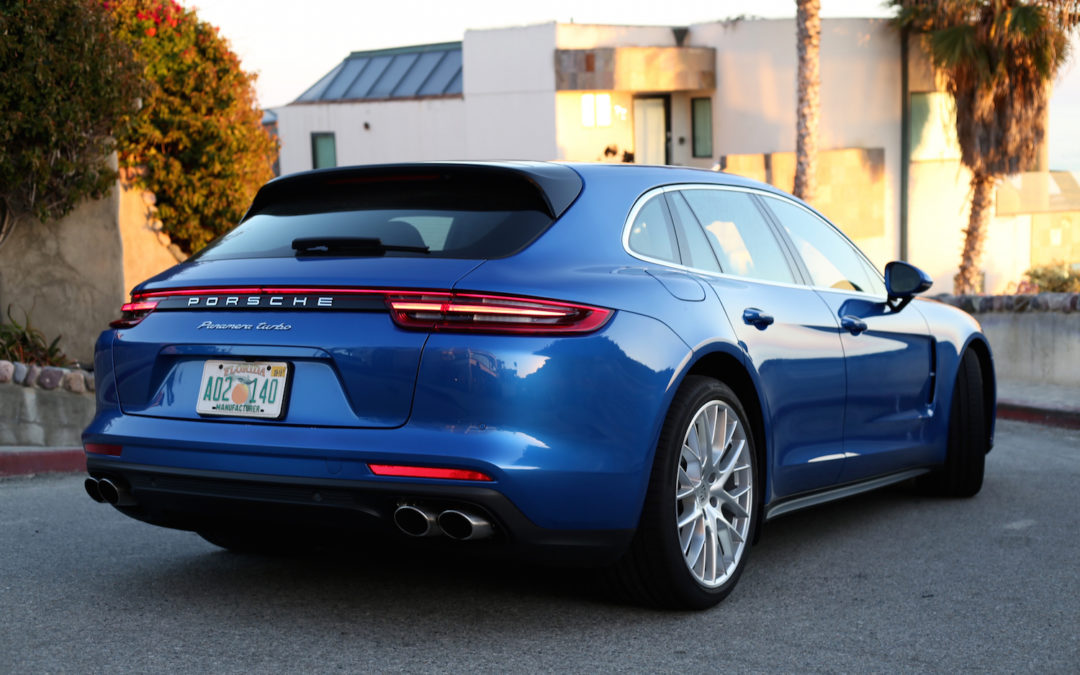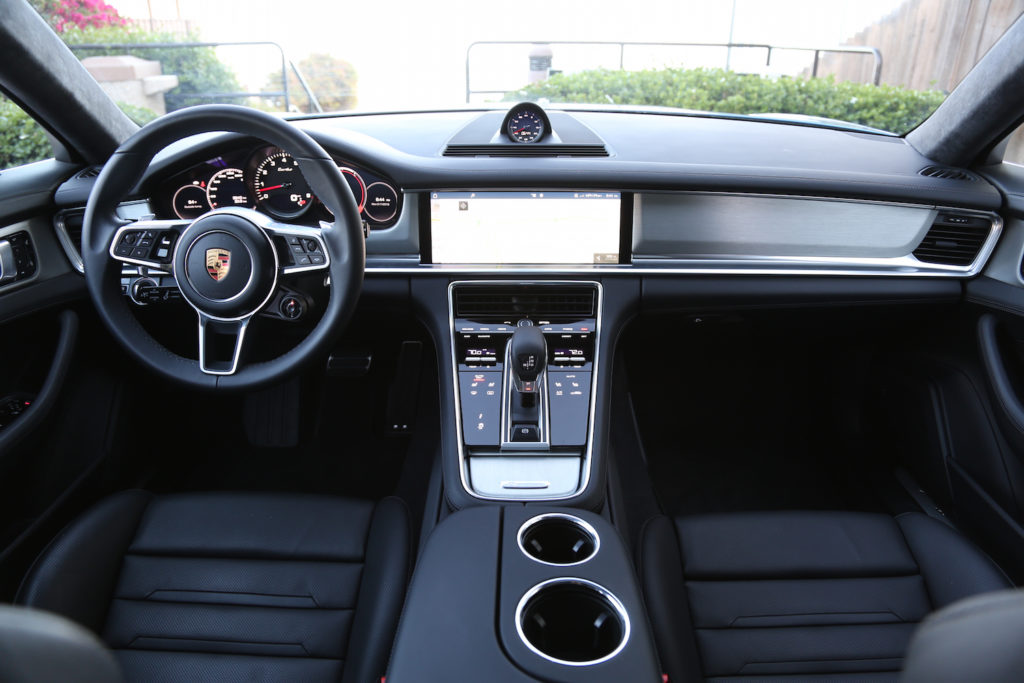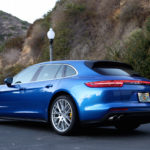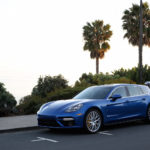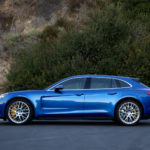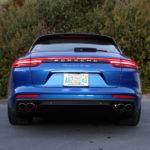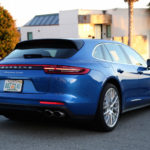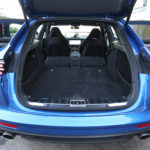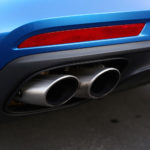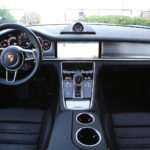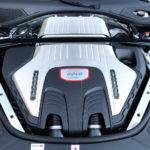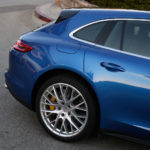The Porsche Panamera Turbo Sport Turismo is a vehicle of sheer excess – of sheet metal, horsepower, sophisticated technology, premium details, and characters in its name. There is no practical need for a vehicle like this, and yet it exists. How wonderful.
To understand the Sport Turismo, one must reflect on the history of station wagons. Derived from light-duty trucks, wagons originated as wood-paneled commercial vehicles in the 1920s before transitioning into higher priced family haulers in the 1950s. It wasn’t until the late 1960s and that wagons ballooned in size and assumed their iconic status as utility vehicles. Later years weren’t as kind to the station wagon, and the rise of the SUV all but eliminated the body style from the U.S. market.
Today, the resurgence of the wagon is owed to niche marketing. Without room to blossom as a utility vehicle, automakers position their long-roofed models as all-terrain tools (e.g., Audi’s allroad and Volkswagen’s Alltrack) or premium accessories (Porsche’s Panamera Sport Turismo). While similar to the 1950s estates, contemporary luxury wagons add a new dimension – performance.
The 2018 Porsche Panamera Turbo Sport Turismo ($154,000) contends with the Mercedes-AMG E 63 S Wagon ($106,950) and Jaguar XF Sportbrake S ($70,450) for as much of this micro segment as possible. Our tester comes equipped with a long list of performance add-ons to bring the price tag up to an eye-watering $183,060 (excluding destination and handling). So what do you get for all that coin?
For one, a shape like nothing on the road. While the Panamera hasn’t always been beautiful, the second generation (introduced in 2017) refined the car’s rougher edges for cohesively upscale design. The wagon improves upon the Panamera four-door with a more elegant roofline and distinctive profile. Porsche’s signature quad-LED headlights, a ventilated lower fascia, and a sculpted hood frame the front end. 20- or available 21-inch wheel designs encompass massive brakes, color-contrasted to the body. The shooting brake silhouette squats low on its tires like a true performance vehicle.
Track width is substantial — 2.4 inches wider than the XF and 1.3 inches wider than the E63 — and is perceived most clearly from the rear. Striking LED taillights with a full-width top beam sit above four trapezoidal exhaust ports to breakup the rear’s surface area. “Imposing” is the best way to describe the Panamera wagon’s visage – and we dig it.
Interior + Tech
Having spent some time in Porsche’s 911 GT3, it’s a bit of a shock to climb into the Panamera’s cabin. Compared to the minimalist, driver-focused 911 cockpit, the Panamera is more balanced, luxurious, and saturated with technology. Porsche’s performance DNA is clearly represented in both cars – the steering wheel, for example, is of the same design, as is the tachometer-dominated gauge cluster – yet the Sport Turismo appeals to more than just the driver.
Our tester is equipped with black leather seats and brushed aluminum trim, though a wide selection of leather colors and accompanying wood or carbon fiber trim is available. However you slice it, the Panamera is all class, with comfortable, supportive seats for all five passengers, an elegant glass center stack that frames the gear selector, an Alcantara headliner, and knurled metal controls. Rear passengers gain no additional legroom in the Sport Turismo (vs. the standard four-door), but the extended roofline adds headroom for taller riders. Full-size adults fit comfortably at all four corners, and available rear seat heating, ventilation, and climate controls make each passenger feel at ease.
Dominating the dashboard is Porsche’s latest infotainment system, featuring a stunning 12.3-inch widescreen display and a pair of reconfigurable displays flanking the tachometer. Accessing the module’s advanced functions is a seamless process, and ultra-quick response to inputs makes the central touchscreen a joy to use. Apple CarPlay comes standard, but Android Auto is notably absent. The vivid display houses all media, navigation, telemetry, drive mode, and climate control settings. Alternatively, voice commands, steering wheel controls, and touch-sensitive buttons on the center console can be used to configure these settings.
The 2018 Panamera Sport Turismo is available with a number of driver assistance features. Headlining the package is Porsche’s InnoDrive, a combination of adaptive cruise control, lane keeping assist, and automatic speed adjustment based on posted limits. Unfortunately, the system isn’t equipped on our test model, but based on our experience with the same setup in the 2019 Cayenne, Porsche appears on the cutting edge of semi-autonomous assistance.
How about that trunk, then? At 49 cubic feet with the rear seats folded and 18 with the seats in place, the wagon’s cargo capacity is just 5 cubes larger than the standard Panamera. By comparison, the AMG wagon boasts 57 cubic feet with the rear seats folded and the XF Sportbrake offers a cavernous 69 cubes in the same configuration. Only modest utility gains are a result of the Sport Turismo’s dedication to a provocative silhouette, but there are other benefits. The redesigned hatch on the wagon makes loading far easier than the four-door Panamera thanks to a lower lift-over and a wider trunk opening.
Driving Experience
No amount of mental preparation counters the abnormality of driving a 550-horsepower station wagon. With its mountain of torque (567 pound-feet), the Panamera Turbo Sport Turismo is faster to 60 mph than dedicated sports cars like the BMW M4, while carrying 800 extra pounds. Porsche 4.0-liter twin-turbocharged V8 is significantly more potent than the XF Sportbrake’s 380-hp supercharged V6, but cannot match the AMG E63 S wagon’s 603-hp twin-turbo V8.
All that grunt is served up according to driver preference and inputs. With the help of a sophisticated network of stability and traction control systems, Porsche’s standard eight-speed dual-clutch transmission (PDK) and all-wheel drive system effectively convert thrust into forward momentum.
Wielding supercar-levels of power is almost effortless in Normal drive mode, where it takes a full plunge of the throttle to wake the V8 beast. Cranking the steering wheel-mounted drive mode selector to Sport puts the Panamera in our favorite configuration. Steering, throttle, and transmission responsiveness increases, but only to an enjoyable level for daily driving. One more turn of the dial to Sport Plus completely transforms the five-door into a taut, snarling animal. Pushed to the bleeding edge on a track, Sport Plus makes perfect sense, but in the real world, there’s little need to play hero in something this large.
Speaking of size, the Panamera initially feels extra thick within its lane, appearing to have a wheel at each marker. With more time behind the wheel, however, this wide-body sensation lessens and is replaced by awe for Porsche’s chassis tuning. Our tester came with Porsche Dynamic Chassis Control Sport (PDCC Sport) and Porsche Torque Vectoring Plus (PTV Plus). We had to type that out five times to make sure we hadn’t added words. In colloquial terms, the system reduces body roll and increases stability based on driving behavior. Combined with optional carbon ceramic brakes, the Turbo Sport Turismo defies all logic with its dynamic sass. It’s no 911, but the Porsche DNA is clearly felt through the steering wheel.
For all its performance, the Panamera wagon never yields an ounce of luxurious ride quality. Porsche’s air suspension management and adaptive dampers quell the harshness of road imperfections (even while riding on low-profile tires). Wind noise is also minimal thanks in part to an adaptive rear spoiler that works in conjunction with the panoramic sunroof to deflect air. Enjoying a responsible average of the car’s diverse driving behavior results in a respectable 20 combined mpg (2 mpg more than the AMG and 2 mpg fewer than the Jag).
Our Take
After a week with Porsche’s Panamera Turbo Sport Turismo, we honestly don’t care whether it upholds the principles of a wagon or burps its twin-turbo V8 exhaust in the face of tradition. Fact is, this thing is a miracle in an otherwise cookie-cutter car world. Porsche effectively slapped some production door mirrors on its stunning Sport Turismo Concept, went to obscene (yet typical for Porsche) lengths to engineer sport car driving dynamics, and constructed one of the most luxurious and sophisticated cabins in its class. We adore the Panamera wagon… but it is hard to choke down its price tag.
For $50K less, the Mercedes-AMG E63 S is more powerful and versatile than the Porsche. Or, for even more utility and a total $80K in savings compared to the Sport Turismo, Jaguar’s XF Sportbrake S is on the table. What these vehicles both lack, however, is swagger. We find ourselves comparing the Panamera Wagon to Ferrari’s shooting brake, the GTC4 Lusso, while the same matchup would never happen for either the AMG or the Jag.
Porsche broke a mold with this vehicle, leaving its competitors utterly stumped.
$150K is a hefty sum, but the 2018 Porsche Panamera Turbo Sport Turismo is totally worth it.

